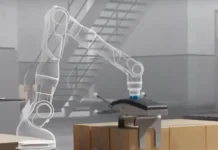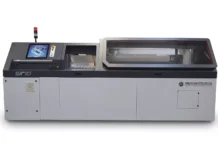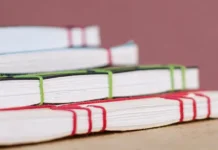by: Steven Calov, Heidelberg USA
In the finishing realm, perfect binding plays an important role in promoting efficient operations and fast turnarounds as the market moves toward digital print. As print becomes more prominent as a marketing piece, short-run perfect binding is becoming more desirable, compared to stitched products.
Speaking of digital print, its suitability for short and ultra-short runs and smaller formats is a given; however, there is more to the story, based on changes in the marketplace that have revised traditional thinking about short-run approaches to the finishing of digitally printed output.
The market dictates the pace of change, moving toward shorter print runs and faster delivery times, as well as a leveling of the playing field between the finishing of conventionally and digitally printed products in the smaller (20″) formats that are currently digital’s sweet spot. In this new environment, printed materials arrive ready for finishing off a variety of output devices, while finishing requirements are being met with a variety of in-, off- and near-line solutions, depending on volume and whether the aim is to print one or 1,001.
Digital Dollars
Like digital printing, digital finishing is driven by performance, quality and cost. Some digital printing devices are equipped with finishing units capable of performing binding and finishing functions – including perfect binding – in-line. This makes the process of printing a complete book more efficient because it eliminates a material handling step from the workflow, sparing time and expense, but it also can limit an application’s variety and production speed. However, the need to provide fast, inexpensive finishing of digital work using traditional equipment built for offset calls for results-oriented solutions that will add quality and value to the printed piece, bring cost efficiency to bear on the finishing process and keep profit margins high.
Perfect or adhesive binding is a method of binding single sheets – as opposed to signatures – into a book. Many digital books are printed as stacks of single sheets. One of the most easily automated of finishing processes, perfect binding’s low cost makes it a popular choice for binding a variety of printed matter, wherein single sheets are gathered, stacked and the binding edge covered with glue. A cover is attached to the book and is held in place by the glued spine. Then, the entire product is three-side trimmed on a dedicated trimmer or guillotine cutter.
Professionally perfect-bound books have square backs, smooth spines and adequate adhesive strength to prevent the pages from being pulled from the binding. The only way to accomplish this used to be with large off-line production machines, which required lengthy makereadies and resulted in expensive short-run applications. The larger off-line perfect binders were better suited to longer print runs. In recent years, however, a combination of factors has prompted printers to seek out small-format standalone perfect binders to accomplish low-volume, short, ultra-short and one-off run digital work in-house. These factors begin with the rise of specialty print products, such as digital photobooks, and extend to commercial printers offering custom and on-demand services to their customers. Rising transportation and delivery costs also have played a role in the shift to in-house production.
Designed for Digital
An alternative to large off-line binding devices are smaller, economical, off-line perfect binders, which are compatible with or specifically designed for small digital print applications and have the capability to produce perfect bindings that are of nearly the same quality as the bindings produced with the larger machines. The overhead cost is much less than the larger machines and makeready times are greatly reduced.
Solutions answering these needs are modular, flexible, integrated, run at speeds as fast or faster than the output device and offer multiple opportunities for reductions in labor, including quality verification. They are easy to operate and quick to set-up for new jobs, and, last but not least, feature connectivity and JDF. They are machines that can handle books from digital printers and offset presses and perfect bind books of one or 1,000 quickly, efficiently and profitably.
A Sticky Wicket
Are there challenges presented by the perfect binding of digital print? Yes. Among the biggest are failure to form a durable adhesive bond on digitally qualified papers, as well as the potential cracking of inks and coatings. In particular, the presence of fuser oil left on digital sheets can have a severe impact on the pull-strength of a digitally printed, perfect-bound book when hot-melt adhesives are used. Toner can have the same effect if the printing bleeds into the spine of the book.
For these reasons, the perfect binding of toner-based color sheets using conventional hot-melt adhesive has been largely supplanted by the use of polyurethane-reactive or PUR adhesives on fast-makeready binders such as Heidelberg’s entry-level Eurobind 600 PUR. This machine features Heidelberg’s unique nozzle application system, which takes the convenience of PUR glues for adhesive binding of digitally printed materials one step further by minimizing (expensive) PUR glue exposure, giving a more consistent glue line on the cover of the book, and saving time and money over open tank systems. While PUR is more expensive than traditional hot-melt adhesives, it also lasts longer, weathers extreme temperatures, looks good and holds difficult plastic or coated stocks reliably. PUR technology ensures reliably high adhesion to the sheet edges so finished products can be opened flat without problem, even with difficult materials such as heavily coated papers and digital print products.
But don’t count hot-melt down and out just yet. While PUR provides an added measure of safety that the job will not be rejected, it also adds significant cost. Given the recent migration to inkjet and oil-less fusing of toner based products, however, hot-melt glues can provide a more cost effective solution as long as the spine preparation is sufficient to result in good book adhesion (good pull results). At least one perfect binding operation in a digital print environment we know of has spent effort to prepare the spine very well in combination with hot-melt glue to produce excellent results. It will be interesting to see whether PUR or hot-melt “wins” in the coming years, or whether both will share this space.
A Trimming Dilemma
We also should mention trimming. Trimming is accomplished with either a dedicated three-knife trimmer or a guillotine paper cutter. The issue with three-knife trimming is that the capital cost for the machines is most often above $100,000 US, while the quality of trimming delivered by machines currently on the market often is not up to market expectations, due to spine knicking. A cost-effective alternative is to use a guillotine cutter instead, even though it adds another material-handling step to the process. Heidelberg has studied the problem and found that at quanitities up to 1,000 books per hour, the cost and productivity of guillotine trimming can be advantageous. Over the very short run, the challenge is to reduce the makeready of the cutter from book to book size, so equipment suppliers are exploring ways to add automation to the cutting process. By sending the cutting parameters to the guillotine at the point of prepress, or by using a bar code on the book to load the cutting parameters, the cutting process can be sped up substantially while reducing re-runs and waste.
Seize the Day
Short-run perfect binding today denotes not just shrinking order quantities, but also foreshortened turnarounds and product flexibility demanded by customers who now have the option to produce low-cost books in the quantities – as small as one – they need. Manufacturers of finishing equipment are seizing the opportunity to fine-tune their equipment to handle the requirements of digital output. As mentioned above, today’s high-speed automated perfect binding machines can execute digitally printed, perfect-bound books in in-line, off-line and near-line configurations (useful in cases where the binder runs faster than the output device). Lift-type deliveries are designed to ensure superior glue stabilization and gentle transport of the book block in different production environments.
Automated components are designed to facilitate the adjustment of clamp opening widths; integrated pressing, scoring and spine preparation; gluing length control and more. Meanwhile, the addition of exchangeable hot-melt and PUR glue tanks, variable clamps, self-calibrating missing sheet detectors and graphical touchscreen controls for shorter set-ups, lower waste and faster turnarounds mean that top-quality, digitally printed, adhesive-bound products can be produced quickly and economically on traditional perfect binding equipment from offset or digital streams, with disparate jobs ganged together for maximum efficiency.
Advances in finishing automation are being driven by the rise in digital printing, characterized by declining run lengths, quick turn requirements and the need to train workers quickly. As run lengths get shorter, set-up time becomes a bigger percentage of the total job time, driving up the labor cost per unit produced. Because traditional equipment built for offset printing typically requires more makereadies for digital work, regardless of run length, the reduction, elimination and/or automation of costly extra steps is an operational imperative. The goal? The ability to finish digitally printed output at high speeds, in real time, with no waiting, at the highest quality.
Steve Calov is postpress product manager for Heidelberg USA. A leading solution provider for the print media industry, Heidelberg manufactures precision printing presses, platesetters, postpress equipment and software for integrating all printshop processes. For more information, visit www.us.heidelberg.com or call 770.419.6500.




